The Automotive Tech Week event running Nov. 15-19 covered automotive interiors, ADAS and autonomous vehicle technology, advanced propulsion, and automotive user experience topics. The exposition associated with the event featured examples of technical advances now making their way into the designs of automotive OEMs. Here are a few of the more notable developments we saw on the show floor.
Award-winning vehicles
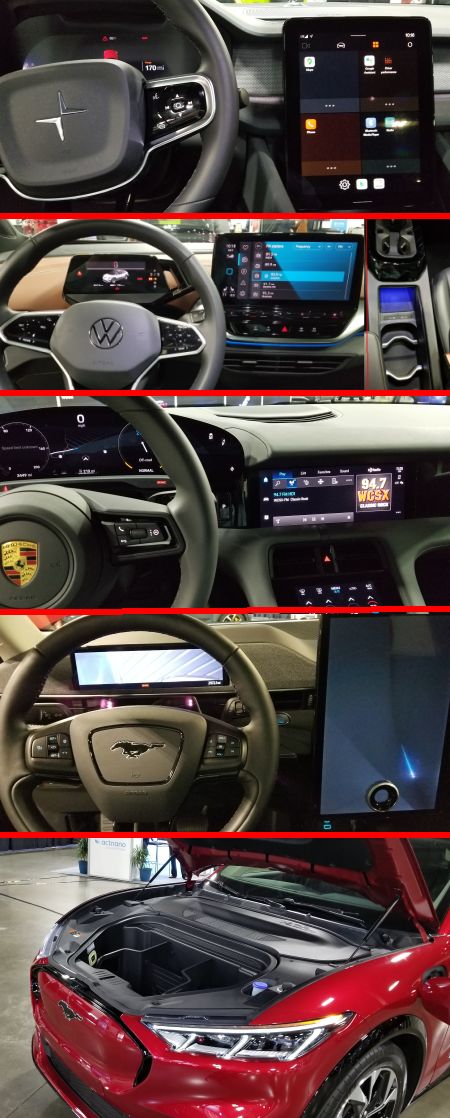 Some of the winners of Wards Automotive’s 10 Best competition were on display at the expo. One thing was clear: Physical buttons are out of style in vehicle cockpits. Instead, vehicles coming off the assembly line increasingly depend on voice commands and big, high-definition touch screens to handle controls. Examples of the trend were evident in the Polestar 2, (top) winner of both a Wards 10 Best user experience and engine & propulsion systems award. The Volkswagen ID.4 (next) kept with the theme and even included a UV-C disinfection light in its upper console area (visible to the right). Ditto for the Porsche Taycan (next) and the Ford Mustang Mach-E. We must say, though, it seemed weird to open the hood of a Mustang and see nothing but a laundry basket-style storage area (bottom).
Some of the winners of Wards Automotive’s 10 Best competition were on display at the expo. One thing was clear: Physical buttons are out of style in vehicle cockpits. Instead, vehicles coming off the assembly line increasingly depend on voice commands and big, high-definition touch screens to handle controls. Examples of the trend were evident in the Polestar 2, (top) winner of both a Wards 10 Best user experience and engine & propulsion systems award. The Volkswagen ID.4 (next) kept with the theme and even included a UV-C disinfection light in its upper console area (visible to the right). Ditto for the Porsche Taycan (next) and the Ford Mustang Mach-E. We must say, though, it seemed weird to open the hood of a Mustang and see nothing but a laundry basket-style storage area (bottom).
Virtual reality in automotive design
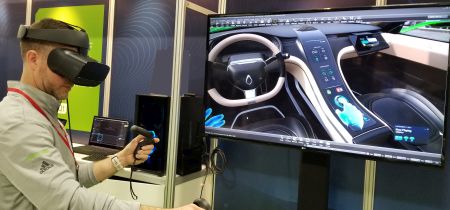 The Qt Group out of Helsinki fields a cross-platform software framework for the development of apps and devices. One of its products, called Qt Creator, is an IDE that includes features such integrated visual editors for building C++ widget-based applications or animated UIs with ready made controls. Another package called Qt Design Studio is a design tool for building UI software. At the expo, Qt personnel used their software to take an AutoCAD model of a car interior and put it in a form that could be used interactively with an Oculus headset and controls, here demonstrated by Qi senior tech artist Shawn Dorsey.
The Qt Group out of Helsinki fields a cross-platform software framework for the development of apps and devices. One of its products, called Qt Creator, is an IDE that includes features such integrated visual editors for building C++ widget-based applications or animated UIs with ready made controls. Another package called Qt Design Studio is a design tool for building UI software. At the expo, Qt personnel used their software to take an AutoCAD model of a car interior and put it in a form that could be used interactively with an Oculus headset and controls, here demonstrated by Qi senior tech artist Shawn Dorsey.
Not your ordinary navigation system
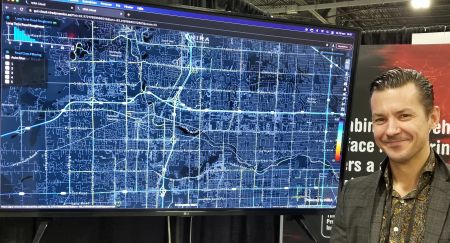 Owners of recent-vintage vehicles are probably accustomed to seeing displays something like this one on their auto nav systems. But the Road Surface Alerts technology, from Nira Dynamics AB in Sweden, is like a nav system on steroids. The idea is to collect information about road conditions from other vehicles and use it to give drivers an early warning about problems such as congested traffic or slippery roads ahead. Eventually, says Nira head of marketing and communications Johan Hägg, the system will even be able to adjust the ride qualities of the vehicle to handle upcoming rough roads. The system is now in use by Audi whose vehicles have been able to warn each other about accidents, broken-down vehicles, traffic jams, road ice, or limited visibility. The Nira system adds high-precision cloud data to make alerts even faster and more precise. Audi is the first vehicle maker to utilize the technology.
Owners of recent-vintage vehicles are probably accustomed to seeing displays something like this one on their auto nav systems. But the Road Surface Alerts technology, from Nira Dynamics AB in Sweden, is like a nav system on steroids. The idea is to collect information about road conditions from other vehicles and use it to give drivers an early warning about problems such as congested traffic or slippery roads ahead. Eventually, says Nira head of marketing and communications Johan Hägg, the system will even be able to adjust the ride qualities of the vehicle to handle upcoming rough roads. The system is now in use by Audi whose vehicles have been able to warn each other about accidents, broken-down vehicles, traffic jams, road ice, or limited visibility. The Nira system adds high-precision cloud data to make alerts even faster and more precise. Audi is the first vehicle maker to utilize the technology.
….And you thought GPS antennas were simple….
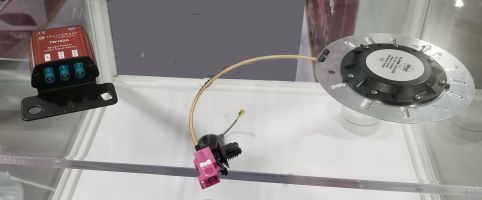 Visible here are a splitter (left) and an antenna for a GPS system as will be installed on electric vehicles from an automaker that can’t be named. As explained by their creator–Tallysman in Ottawa, Canada–they are much more sophisticated than ordinary antennas designed for use in GPS work. Antennas in present-day nav systems don’t need to provide a lot of precision because they only provide directions for the driver. But autonomous systems will use more precise phase tracking which demands use of antennas with a broader bandwidth, high rejection of both near-frequency interference and multipath signals. Moreover, reflected GNSS signals switch from right-hand polarization to elliptical or left-hand polarization. So the antenna itself, not just the receiver, must be designed to mitigate these problems. The triple-band device visible here incorporates, among other things, a ground plane, radome, and a means of mitigating cable vibrations.
Visible here are a splitter (left) and an antenna for a GPS system as will be installed on electric vehicles from an automaker that can’t be named. As explained by their creator–Tallysman in Ottawa, Canada–they are much more sophisticated than ordinary antennas designed for use in GPS work. Antennas in present-day nav systems don’t need to provide a lot of precision because they only provide directions for the driver. But autonomous systems will use more precise phase tracking which demands use of antennas with a broader bandwidth, high rejection of both near-frequency interference and multipath signals. Moreover, reflected GNSS signals switch from right-hand polarization to elliptical or left-hand polarization. So the antenna itself, not just the receiver, must be designed to mitigate these problems. The triple-band device visible here incorporates, among other things, a ground plane, radome, and a means of mitigating cable vibrations.
When there’s no room for Cat 5 cable
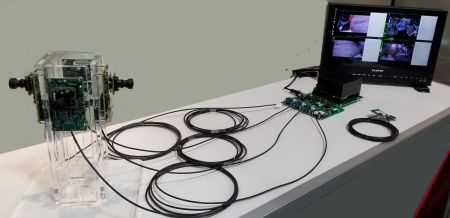 Most people get their internet data over some collection of Cat 5 cables and RJ-45 connectors. But this kind of connection doesn’t cut it in vehicles—the cables and connectors are relatively heavy and take up too much space. That’s the reason Valens in Israel came up with its network daisy chaining scheme for vehicle infotainment systems. The latest version of the Valens chipset is the VA7000 series which enables the aggregation of gigabit Ethernet, digital audio, and I2C control over a thin UTP cable which can be up to 15 m long and include up to four small, light, inexpensive in-line connectors as visible in the lower image. This particular demo represented a head unit getting video feeds from four vehicle-style video cameras. Each hop in the chain runs at 4 Gbps to support the upcoming MIPI A-PHY v1.1 spec. Another point to note: No separate power cables. The camera power also comes via the UTP.
Most people get their internet data over some collection of Cat 5 cables and RJ-45 connectors. But this kind of connection doesn’t cut it in vehicles—the cables and connectors are relatively heavy and take up too much space. That’s the reason Valens in Israel came up with its network daisy chaining scheme for vehicle infotainment systems. The latest version of the Valens chipset is the VA7000 series which enables the aggregation of gigabit Ethernet, digital audio, and I2C control over a thin UTP cable which can be up to 15 m long and include up to four small, light, inexpensive in-line connectors as visible in the lower image. This particular demo represented a head unit getting video feeds from four vehicle-style video cameras. Each hop in the chain runs at 4 Gbps to support the upcoming MIPI A-PHY v1.1 spec. Another point to note: No separate power cables. The camera power also comes via the UTP.
An operating system for software-defined vehicles
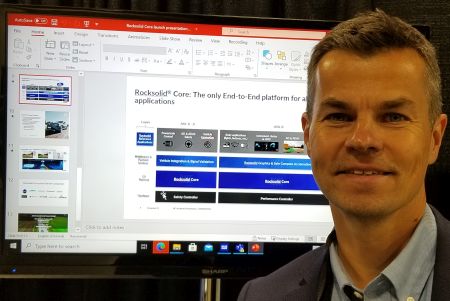 Most automotive OEMs probably would rather spend their time working on product features that will differentiate them rather than on the bowels of operating system software. That’s the thought behind an automotive operating system called Rocksolid Core from Basemark in Finland. As diagrammed on the slide behind Basemark COO Sami Niska, the OS execution environment and platform covers all vehicle functions, ranging in safety critical levels from ASIL-B to ASIL-D. It is based on Autosar Classic, Autosar Adaptive and Linux, coupled with the firm’s high-performance compute and graphics libraries middleware. Basemark says its vision stack and safe HMI utilize a target platform’s accelerators, GPUs and CPUs in such an optimal way that OEMs may be able to reduce the number of processors the application requires. Rocksolid Core also comes with reference applications for ADAS and HMI. Moreover, licensing scheme is such that OEMs actually get source code so they can maintain their codebase and modify and develop new applications as time goes on.
Most automotive OEMs probably would rather spend their time working on product features that will differentiate them rather than on the bowels of operating system software. That’s the thought behind an automotive operating system called Rocksolid Core from Basemark in Finland. As diagrammed on the slide behind Basemark COO Sami Niska, the OS execution environment and platform covers all vehicle functions, ranging in safety critical levels from ASIL-B to ASIL-D. It is based on Autosar Classic, Autosar Adaptive and Linux, coupled with the firm’s high-performance compute and graphics libraries middleware. Basemark says its vision stack and safe HMI utilize a target platform’s accelerators, GPUs and CPUs in such an optimal way that OEMs may be able to reduce the number of processors the application requires. Rocksolid Core also comes with reference applications for ADAS and HMI. Moreover, licensing scheme is such that OEMs actually get source code so they can maintain their codebase and modify and develop new applications as time goes on.


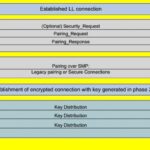

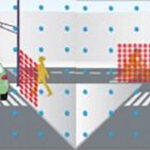

Leave a Reply